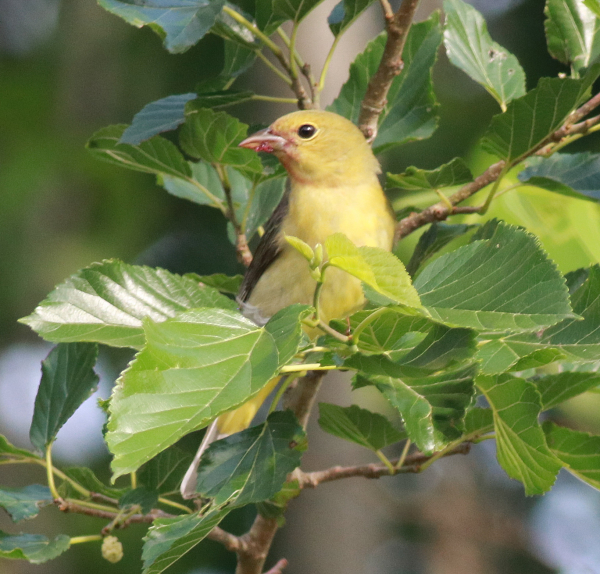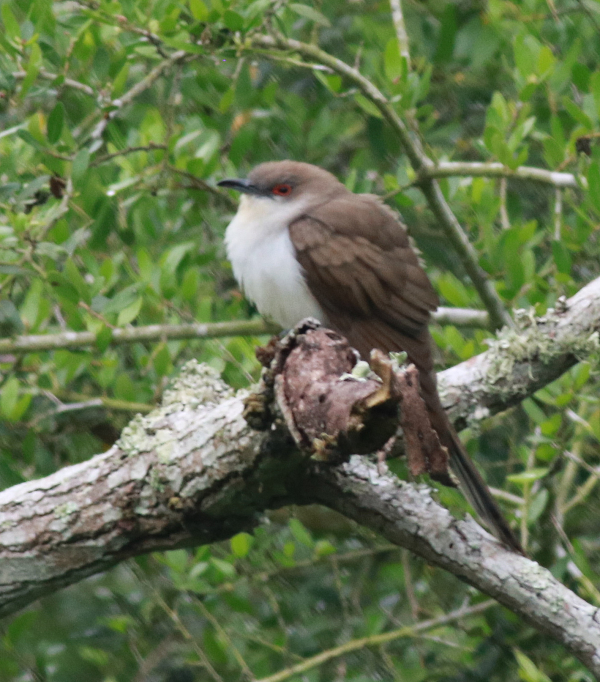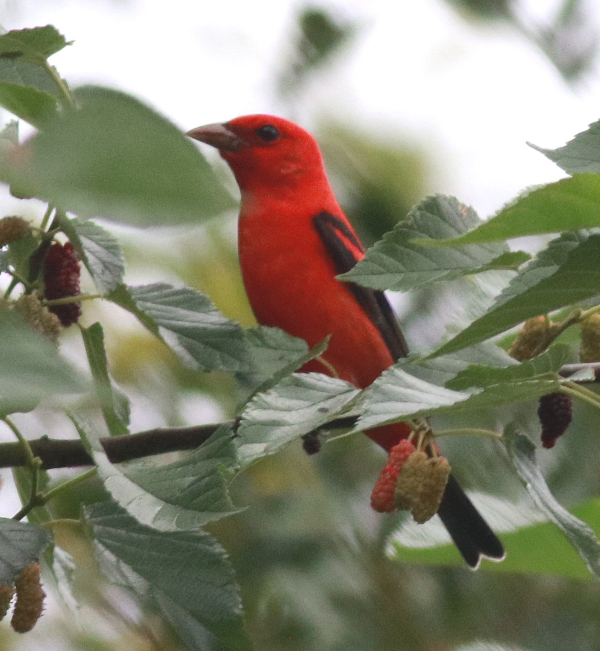
A female Scarlet Tanager that slipped into the open during Sunday’s sunny afternoon provided one of the best images of migrating songbirds.

A documentary photo of the Black-belled Cuckoo as it rested and cooled during what was probably its first stop after a trans-Gulf migration flight.

This male Scarlet Tanager has a thin red wing bar, most uncommon if not unusual. This feature was not evident in the field, but only noticed during a review of the day’s photos.
|
It’s hard for anyone else to believe, or understand – well, most people anyway – but I blame it on a crazy combination of “warbler fever, tanager fever, and bunting fever!” I’m back in southeast Texas to catch the second half of neotropical songbird migration here from wintering areas in Mexico, Central America, and northern South America. To be honest, I started planning my return only 2 days after returning home after a month on the road during my Gulf Coast birding trip, and a week ago I hit the road again for my return.
You’d think I would have been satiated with birding travel, if not tired of driving thousands of miles cross country, but frankly, that’s what I do – if I don’t fly to another country or continent. So Thursday morning, I was back walking atop the Canopy Walkway in High Island, concentrated on the beautiful diversity of trees for movements of warblers, tanagers, buntings, orioles, thrushes, vireos, and more. Where they at? I was quickly reminded how my senses become acutely aware of the movement of every leaf, along with any sounds to help zero in on hidden songbirds foraging within my view.
The high point that first morning was to see and try to photograph an impressive Black-throated Green Warbler and 2 Tennessee Warblers in a nearby tree at eye level. I observed another half dozen warblers from a distance, most of which were either Orange-crowned or Tennessee Warblers, although it was hard to tell from that distance. Another quick glimpse of a bird indicated a female Summer Tanager on the move. I worked pretty hard for a couple hours with little songbird payoff, but appreciated things change quickly in the realm of migrating songbirds and that patience is usually rewarded.
Bolivar Beach Cruise
By noon, I decided to opt for Plan B and take a beach cruise along the upper Bolivar Peninsula, which begins less than a mile south of High Island. In short order I was able to see that 2 new species of terns were among a big mixed species congregation where a freshwater stream met the Gulf waters – Least Terns and Black Terns had joined the Royal, Sandwich, and Forster’s Terns; with Black Skimmers, Sanderlings, Ruddy Turnstones, and a Black-bellied Plover; more than 100 birds total.
There was also a new plover on the beach – the first Wilson’s Plovers had arrived. This species was on my list of birds to find during my circum-Gulf trip, so I was happy to see a few scattered along the sandy beach. The last time I photographed a Wilson’s Plover I was still using slide film in September 2000 along the Gulf Coast of central Florida. The birds were smaller than I remembered with a smaller bill than I remembered, so I was glad to get a new perspective on them, and to get a few digital photos too.
I also found a fully molted Black-bellied Plover in beautiful alternate plumage with a fully black face, throat, breast, and belly, with white border and black and white speckled back such as I’ve only seen on the species’ nesting territory in the Alaska tundra. There were a few scattered Black-bellied Plovers in the upper Bolivar, although others were in varied grades of molt that showed some level of black feathering on their ventral side. I also spied a lone Whimbrel and a Long-billed Curlew separated by a couple miles, and the rare bird of the day was a big female Magnificent Frigatebird gliding above the shore.
As I photographed the Black-bellied Plover, I noticed a white egret-looking bird dashing across a shallow wetland, which by its behavior indicated to me it was a relatively rare white morph Reddish Egret. After photographing the plover, I moved toward the egret, although it was now inanimate, standing very stoically. I hoped for a little action, but I got the next best thing – a back wind that blew its crest forward to form a funny crown around its head and provide a touch of character to the unconcerned and uninterested wader.
By mid-afternoon I returned to the Canopy Walkway to check for songbirds and to photograph at the rookery while the sunlight was right. After walking only about 120 feet up the walkway, I was surprised to find another species I really have not photographed before – a Yellow-crowned Night Heron – close! Hunting the same shallows as turtles and small gators and providing some inanimate images that rivaled the white Reddish Egret. But likewise, it was a great thrill to see and photograph this special bird at close quarters. Songbirds were absent from the space, but I enjoyed getting back into sync photographing big pink birds and other wading bird delights.
What a Cuckoo Afternoon
As expected, it rained Friday morning (April 30), providing some extra sleep time I apparently really needed. So what would the rain do? Produce a songbird fallout? I felt like I was just going through the motions as I drove to High Island, and as I did my usual slow drive through some promising streets, including past the Boy Scout Woods, Eubank Woods, and various landscaped yards – nothing. But that’s what I expected, and I turned down the road to my true destination, Smith Oaks, expecting no more.
But there was a van pulled over with binoculars drawn, so I stopped as I reached the halfway point down the Smith Oaks road. In a few low bare trees I counted 15 Eastern Kingbirds with about 5 Yellow Warblers actively foraging in their midst; hmm. Next I spied a Cedar Waxwing, then a Loggerhead Shrike, and a beautiful beaming red Summer Tanager made me appreciate every molecule of the bird; a male Rose-breasted Grosbeak showed up, and then a dramatic male Scarlet Tanager – and there’s a female! Something was definitely happening here!
After parking my van, a loose flock of about 30 Eastern Kingbirds flew low overhead reminiscent of swallows. I figured the Canopy Walkway must be hoppin’ and I barely started up the ramp before bisecting a moving group of warblers – a Blackburnian, a Yellow, a Black-and-White, and a Bay-breasted Warbler! WoW, what a great start! After that, I enjoyed wave after wave of warblers, usually 5 to 12 moving quickly in and out of sight through the trees, often at eye level, which is mid-story from the Canopy Walkway. But by mid-afternoon a couple warbler waves stood out, one with more than 20 warblers, and another with more than 30. Many more Tennessee and Yellow Warblers would follow, Black-throated Green Warblers, Magnolia Warblers, and more Blackburnian Warblers, which must be the most beautiful of them all; plus occasional Baltimore Orioles, and my favorite non-warblers of the day – Scarlet and Summer Tanagers.
Later I would find out that the morning was quite quiet, and the waves of songbirds began about the time I arrived – “timing is everything,” right? More and more birders arrived, a bit disappointed with their earlier stops and delighted to find the birds arriving at Smith Oaks. Throughout the afternoon there was a growing camaraderie among the people who gathered by twos and threes, adding to the fun of birding in the dreary overcast weather that created such a impromptu birding event.
After 2pm, the periods between songbird waves became a little longer, but there were other birds to hold people’s attention. Primary among these were cuckoos. One after another Yellow-billed Cuckoos availed themselves to views in fairly open perches. But the bird of the afternoon may have been a Black-billed Cuckoo that perched on a snag in the open for about 45 minutes to the delight of many birders, many of whom had never seen the species before – including me! I actually found the bird initially, moments after pointing out a Yellow-billed Cuckoo to a couple. But I pointed it out as a Yellow-billed Cuckoo, not verifying the bill color before pointing it out to another birder, who saw it was a Black-bill – a little teamwork helped in a big way, and in this case, it added a life bird to many people’s lists that day. Now that’s a cuckoo story!
As I contemplated leaving about 4pm, a wave of more than 70 small songbirds dropped in – mostly Yellow and Tennessee Warblers, with a variety of species mixed in such as Yellow-throated, Red-eyed, and White-eyed Vireos; a Nashville Warbler, a Chestnut-sided Warbler, Black-throated Green Warblers, Magnolia Warblers, Blackburnians, American Redstarts – Remarkable! After the excitement of that big wave dulled, I decided to take a break, although it would turn into my exit. Even so, as I left the parking area, birders were pulled over near a lone tree filled with Scarlet Tanagers and warblers – a memorable end to a stunning fallout afternoon at Smith Oaks.
Tanager Time
I didn’t know what to think about the effect of a rain shower Saturday morning – another fallout afternoon perhaps? After parking at Smith Oaks, I sat in my vehicle a bit to watch for any indication of songbird action. Even in the rain Scarlet Tanagers, Baltimore Orioles, Rose-breasted Grosbeaks, Summer Tanagers, and Gray Catbirds were actively feeding in a mulberry tree, which got me excited, but also made me wish for sunshine to photograph the birds better. That berry-laden tree was definitely a “bird magnet.” As the rain subsided I stepped outside, sprayed myself with mosquito repellent, and headed for the Canopy Walk.
Immediately I was bombarded by exciting warbler action that seemed to fill the area – lots of Tennessee Warblers, with some Yellows and a female Bay-breasted, a Black-and-White, and a Blackburnian, along with more tanagers and orioles, and plenty of cardinals. I imagined the action would continue through the afternoon, but I should have known better considering the previous afternoon’s rhythm. When birds cleared out, I recalled how waves of birds moved through, and waited for coming waves, but waited in vain. Even so, I enjoyed some longer visits with a few birders I became familiar with the past couple days, and appreciated the low-key conversations and sharing of information and experiences.
When I decided to break away, activities at another mulberry tree along the driveway caught my attention, and after seeing the feeding frenzy going on, I thought: “Why not park here a bit and try to get some tanager photos? Good idea, get a little ‘mobile blind’ action in!” Even though there was a low sunlight quotient, I enjoyed getting a few photos of Scarlet Tanagers, almost all males. What exciting birds they are! And I think I appreciate the Summer Tanagers even more, but although some Summers were present, they didn’t provide very good photo ops compared to the Scarletos.
When I had a chance to review the photos, which were really only of documentary quality due to the lack of sunlight, but as is usual when I checked out the an enlarged photos I found an interesting anomaly: One male with red wing bars (their wings are usually totally black in alternate plumage). The best female tanager photo was of a female Summer Tanager that showed some orange color on its tail and vent feathers. Was that “normal” for a female, or is this a yearling male showing the very beginning of molt? I checked my field guide and found that indeed, most female Summers have some red-orange coloration in their vent or tail area. Actually, that effort and reviewing information in my favorite field guide helped me appreciate the finer points of Summer–Scarlet differences, especially among the females. Aah, tanagers at last!
Sunday Sunshine
Hoooray, mid-afternoon Sunday the clouds vanished and a scattering of songbirds remained at High Island after the Friday and Saturday fallouts. I checked back to the mulberry tree and saw the tanagers had been replaced by twice as many Cedar Waxwings along with plenty of Gray Catbirds. I did encounter more Scarlet and Summer Tanagers that tantalized me, but only a pretty female Scarlet Tanager provided a couple keeper photos. I also had a shared Magnolia Warbler photo session, shared with 7 other photographers on the Canopy Walkway.
It was another fun afternoon to interact with birders along the walkway, and share the variety of birds that availed themselves within sight. There was also a Chestnut-sided Warbler along with Tennessees and Yellow Warblers, a Common Yellowthroat, Philadelphia Vireos and Red-eyed Vireos, many Baltimore Orioles, 2 female Indigo Buntings, 2 Brown Thrashers, Eastern Kingbirds, and an Eastern Wood Pewee – great fun! I also spent some time at the east deck of the elevated Walkway to photograph at the rookery, specializing on Roseate Spoonbills, Great Egrets, and Neotropic Cormorants, although the highlight was a beautiful and dramatic action photo of a Purple Gallinule landing.
Well, that’s the end of this week’s High Island and Bolivar Peninsula birding action, but there will be a few more stories and photos to share next week. In the meantime, stay alert – wherever you are, wherever you go, birds surround you, and new birds of the spring season should be among them daily. Enjoy the spring parade of birds during this first week of May, the beginning of an especially exciting month for birders!
Article and photos by Paul Konrad
Share your bird sightings and photographs at editorstbw2@gmail.com